The Great Starvation Experiment, 1944-1945
I wrote this brief article a number of years ago. It used to be posted on another site, which no longer exists. So I'm relocating it here. . .
One of the greatest killers of World War II wasn't bombs or bullets, but hunger. As the conflict raged on, destroying crops and disrupting supply lines, millions starved. During the Siege of Leningrad alone, over a thousand people a day died from lack of food. But starvation also occurred in a more unlikely place: Minneapolis, Minnesota. It was here that, in 1945, thirty-six men participated in a starvation experiment conducted by Dr. Ancel Keys.
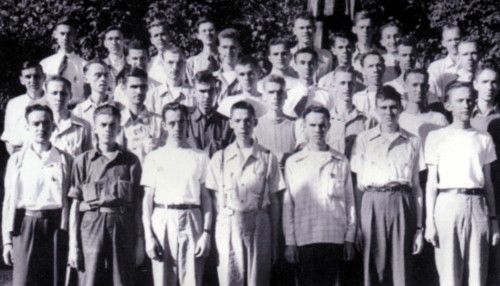
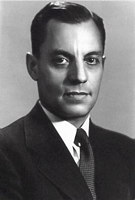 Keys ran the Laboratory of Physiological Hygiene at the University of Minnesota. He had already achieved some fame as the designer of the army's K-rations — the portable combat food rations carried by American troops. (Rumors persist to this day that the "K" in K-rations stands for Keys, though the army has never confirmed this.)
Keys ran the Laboratory of Physiological Hygiene at the University of Minnesota. He had already achieved some fame as the designer of the army's K-rations — the portable combat food rations carried by American troops. (Rumors persist to this day that the "K" in K-rations stands for Keys, though the army has never confirmed this.)
The starvation experiment developed out of Keys' interest in nutrition. He realized that although millions of people in Europe were suffering from famine, there was little doctors could do to help them once the war was over, because almost no scientific information existed about the physiological effects of starvation. Keys convinced the military that a study of starvation could yield information that would have both humanitarian and practical benefits — because knowing the best rehabilitation methods could ensure the health of the population and thereby help democracy grow in Europe after the war. Having secured his funding, Keys set out on his novel experiment.
To find subjects willing to put themselves through such prolonged deprivation, Keys recruited volunteers from among the ranks of conscientous objectors — young men who had chosen to join the Civilian Public Service as an alternative to military service. Many of these conscientous objectors, though not all, were members of the historic peace churches (Brethren, Quakers, and Mennonites).
Keys' staff prepared a brochure designed specifically to appeal to the idealism of these young men. Its cover showed three young children staring at empty bowls, above the words: "Will you starve that they be better fed?"
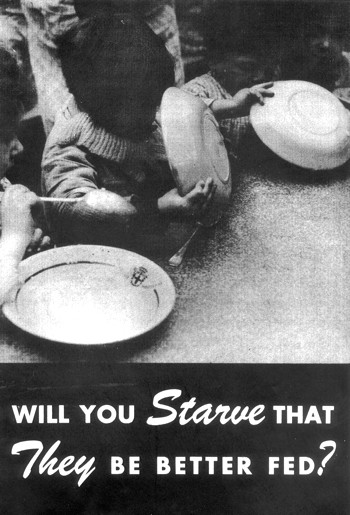
The strategy worked. Even though Keys offered the participants no money, and he warned that prolonged starvation might pose serious health risks, he received over 400 applications. Many conscientous objectors had been put to work in fairly menial jobs, such as repairing rural roads. So the experiment offered them the chance to do something that was both more challenging and seemed of greater humanitarian importance.
Keys carefully screened these applications before finally selecting thirty-six young men who he felt would be tough enough, physically and mentally, to endure what would be demanded of them during the experiment.
The men arrived in Minneapolis in November 1944 and found their way to Keys' Laboratory, which had been temporarily relocated, for the sake of the experiment, to forty threadbare but functional rooms located beneath the university football stadium. The men lived together in a large, dormitory-style room.
For the next week twelve weeks — the control period of the experiment — Keys standardized their diet, allowing them 3200 calories a day, while simultaneously putting them through a battery of tests to gather data on variables such as their heart size, blood volume, hearing, vision, fitness, body fat, and even sperm count. He also ordered the men to maintain an active lifestyle, working jobs in the lab and walking a minimum of 22 miles a week.
Effects of the reduced food intake quickly became apparent. The men very soon showed a remarkable decline in strength and energy. Keys charted a 21-percent reduction in their strength, as measured by their performance on a back lift dynamometer. The men complained that they felt old and constantly tired.
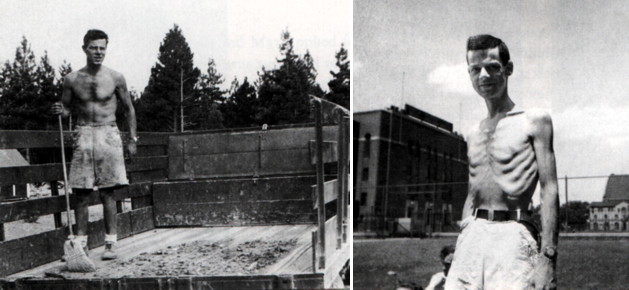
Next a kind of mental apathy took hold of the subjects. The men all had strong political opinions, but as the grip of hunger tightened, political affairs and world events faded into irrelevance for them. Even sex and romance lost their appeal. Food became their overwhelming priority. Some of the men obsessively read cookbooks, staring at pictures of food with an almost pornographic obsession.
Meal times became the high point of their day. They grew irritable if they weren't served their food exactly on time, or if they had to wait too long in line. Although the food was quite bland, to the men it tasted delicious. They lingered over the food, savoring every bite. Often they "souped" their meals — mixing everything with water to make it seem as if there was more.
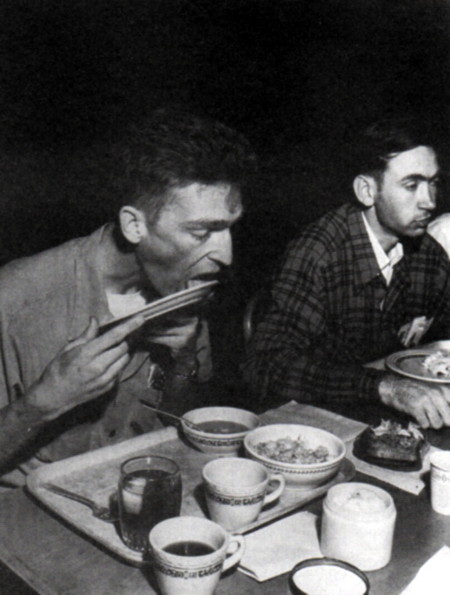
In between the two meals, Keys allowed them unlimited chewing gum, water, and black coffee, and the men took full advantage of these privileges, chewing as many as 40 packs of gum a day and downing up to 15 cups of coffee.
The depth of the psychological strain experienced by the subjects astonished Keys. Although they had all seemed fully committed to the experiment before it began — Keys had screened for this specifically — cheating became a major issue as an almost uncontrollable urge to seek out food gripped them. Keys eventually imposed a "buddy system", allowing none of the men out of the lab unless they were accompanied by a chaperone.
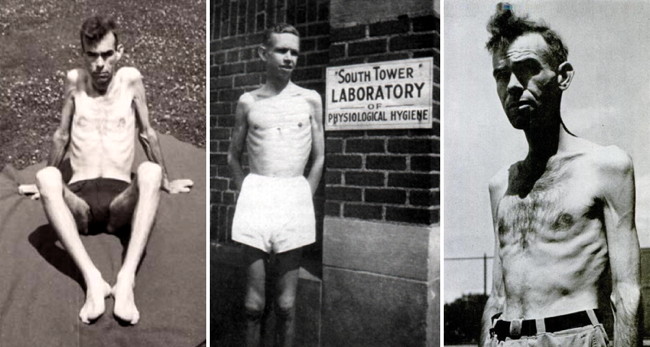
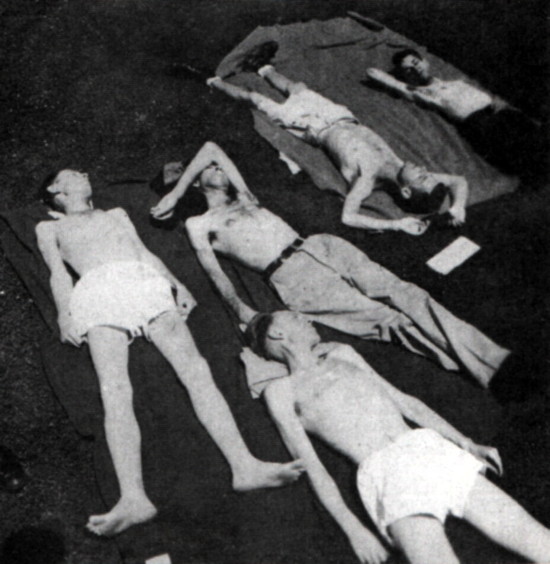
The stress proved too much for one of the men, twenty-four-year-old Franklin Watkins. He began having vivid, disturbing dreams of cannibalism in which he was eating the flesh of an old man. On trips into town (before the buddy system had been implemented), he cheated extravagantly, downing milk shakes and sundaes. Finally Keys confronted him, and Watkins broke down sobbing. Then he grew angry and threatened to kill Keys and take his own life. Keys immediately dismissed Watkins from the experiment and sent him to the psychiatric ward of the university hospital. There, after a few days on a normal diet, Watkins appeared entirely normal again, so the hospital released him. Watkins' breakdown occurred just a few weeks into the starvation phase of the experiment.
Keys later had to dismiss a second subject from the experiment, and he didn't use the data from several of the men in his final report because he suspected, though he couldn't prove, that somehow, despite his precautions, they had continued to cheat.
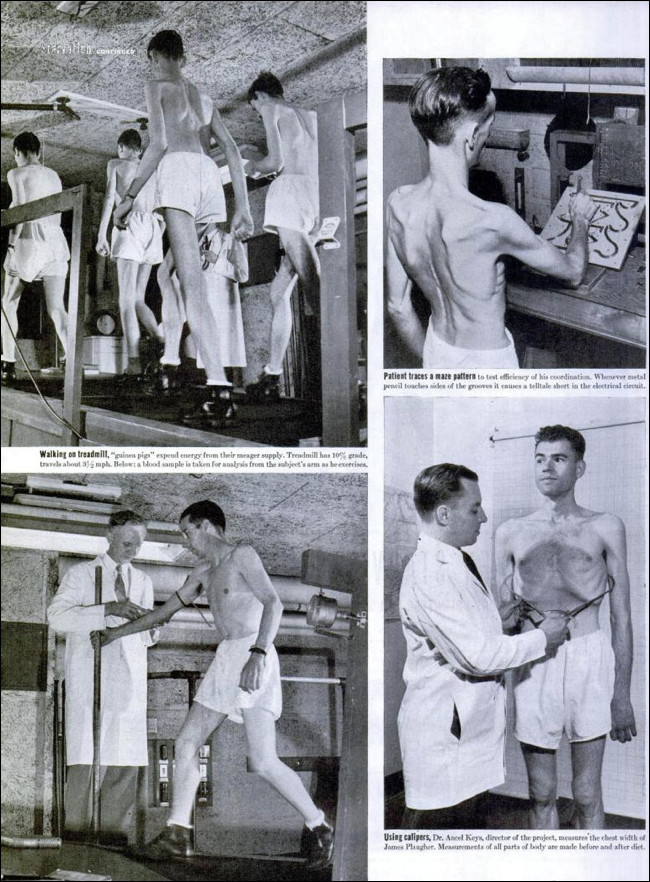
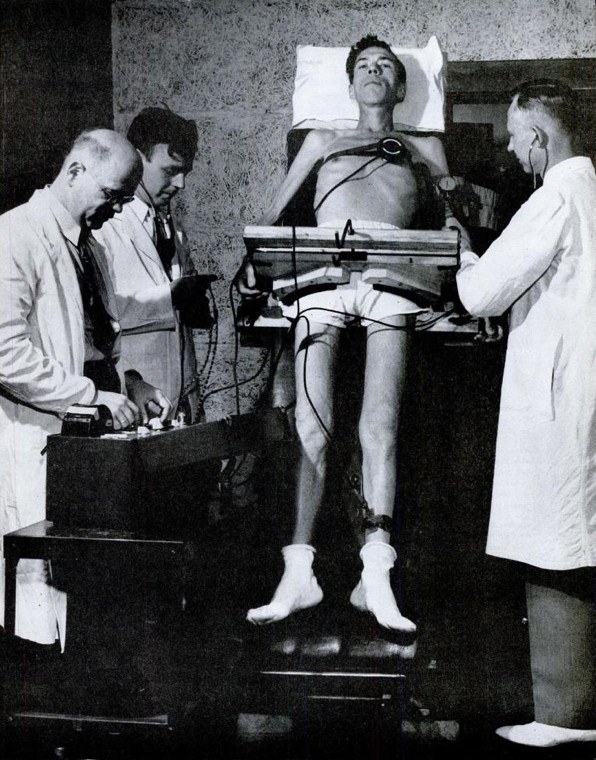
He found that the heart rates of the men slowed dramatically, from an average of 55 beats per minute to 35. This was their metabolism slowing down, attempting to conserve calories. The frequency of their bowel movements fell to about one per week. Their blood volume dropped ten percent, and their hearts shrank in size.
Perhaps because of the amount of water they were drinking, the men developed edema (retention of water). Their ankles, knees, and faces swelled — an odd physical symptom given their otherwise skeletal appearance.
The skin of some of the men developed a coarse, rough appearance, as a result of the hardening of their hair follices. Other effects included dizziness, muscle soreness, reduced coordination, and ringing in their ears. But the creepiest change, which occurred in all of the men, was a whitening of their eyeballs as the blood vessels in their eyes shrank. Their eyes eventually appeared brilliantly, unnaturally white, as if made out of porcelain.
From the men's point of view, the most uncomfortable change was the lack of body fat. It became difficult for them to sit down for long periods of time because their bones would grind against the seats. They also felt cold all the time.
According to folklore, starvation had one positive physiological effect. It supposedly sharpened the senses. Keys hoped to debunk this, so he periodically tested the senses of the men. He found that, as he expected, starvation had no impact on vision, but surprisingly the hearing of all the men did improve as they lost weight. In particular, they heard better at lower frequencies. Keys theorized this was because of a lower production of earwax and an enlargement of their auditory canal as their ear tissues shrank.
Despite all these changes, the men, in their own minds, didn't perceive themselves as being excessively skinny. In fact, they began to think that everyone else looked too fat, rather than they themselves being too thin. Researchers later noted that this is the same mindset displayed by anorexics.
Although they were now in the rehabilitation phase, Keys didn't significantly increase their food levels. Instead, he divided them into four subgroups, which received 400, 800, 1200 or 1600 more calories than they had in starvation. He did this in order to investigate the optimum amount of calories for rehabilitation. But to the men — especially the men in the lowest calorie group — it seemed as if they were barely getting any more food than before. They still felt hungry all the time.
Keys simultaneously gave some of them vitamin and protein supplements, to see if these would aid their recovery. After a few weeks it became apparent to Keys that the supplements were doing nothing to help the men. In fact, the men in the lowest calorie group weren't recovering at all. The only thing that seemed to help was more food. So Keys boosted the food intake of each group by 800 calories, and this had a quick and positive effect. He eventually concluded that in order to recover from starvation, a person needs around 4000 calories a day to rebuild their strength.
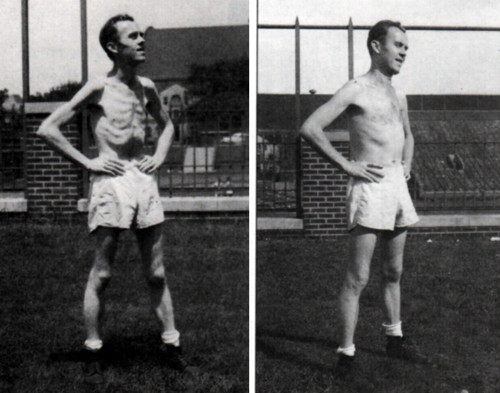
Keys published his full report about the experiment in 1950. It was a massive, two-volume work titled The Biology of Human Starvation. To this day, it remains the most comprehensive scientific examination of the effects of famine. And given modern restrictions on research with human subjects, it seems unlikely that an experiment on a similar scale could be repeated today.
Keys' report highlighted the degree to which what we eat can alter both the mind and the body. However, he also drew an optimistic lesson from the experiment. His data revealed that starvation didn't appear to have any significant, long-term negative impacts on health. The human body had evidently been designed by evolution to withstand long periods without food.
With the starvation experiment behind him, Keys launched into a study of the link between high-fat diets, cholesterol levels, and heart disease. This work eventually earned him international fame, as he became widely known for his warning that high-fat diets increased the risk of heart attacks.
As for the starvation subjects, they drifted back into the general population. Many continued to pursue humanitarian efforts. Quite a few of them volunteered to help with the relief effort in Europe. Three of them became chefs.
Almost sixty years later, in 2003, 19 of the original 36 volunteers remained alive. Of these survivors, 18 were interviewed as part of an oral history project about the experiment. They admitted that there had been some lingering aftereffects of the experiment. For instance, for many years they were haunted by a fear that food might be taken away from them again. But overall, they uniformly praised the experience as one of the most important events in their lives. And they insisted that if they were young men again, they would do it again.
Kalm, L.M. & R.D. Semba (June 1, 2005) "They starved so that others be better fed: remembering Ancel Keys and the Minnesota experiment." The Journal of Nutrition 135(6): 1347-1352. Tucker, T. (2006). The Great Starvation Experiment: The Heroic Men Who Starved So That Millions Could Live. Simon & Schuster, Inc., New York. Keys, A., Brozek, J., Henschel, A., Mickelsen, O. & Taylor, H.L. (1950) The Biology of Human Starvation, Vols. I-II. University of Minnesota Press, Minneapolis, MN. "Men Starve in Minnesota" (July 30, 1945). Life 19(5): 43-46.
One of the greatest killers of World War II wasn't bombs or bullets, but hunger. As the conflict raged on, destroying crops and disrupting supply lines, millions starved. During the Siege of Leningrad alone, over a thousand people a day died from lack of food. But starvation also occurred in a more unlikely place: Minneapolis, Minnesota. It was here that, in 1945, thirty-six men participated in a starvation experiment conducted by Dr. Ancel Keys.

Group photo of the participants
The Purpose of the Experiment

Dr. Ancel Keys
The starvation experiment developed out of Keys' interest in nutrition. He realized that although millions of people in Europe were suffering from famine, there was little doctors could do to help them once the war was over, because almost no scientific information existed about the physiological effects of starvation. Keys convinced the military that a study of starvation could yield information that would have both humanitarian and practical benefits — because knowing the best rehabilitation methods could ensure the health of the population and thereby help democracy grow in Europe after the war. Having secured his funding, Keys set out on his novel experiment.
The Study Design
The basic design of Keys' study was simple: to starve some subjects (or, at least, bring them to near starvation) and then refeed them. To achieve this in a controlled, scientific fashion, Keys envisioned a year-long study divided into three parts: an initial three-month control period during which the food intake of the participants would be standardized, followed by six months of starvation, and then three months of rehabilitation.To find subjects willing to put themselves through such prolonged deprivation, Keys recruited volunteers from among the ranks of conscientous objectors — young men who had chosen to join the Civilian Public Service as an alternative to military service. Many of these conscientous objectors, though not all, were members of the historic peace churches (Brethren, Quakers, and Mennonites).
Keys' staff prepared a brochure designed specifically to appeal to the idealism of these young men. Its cover showed three young children staring at empty bowls, above the words: "Will you starve that they be better fed?"

The strategy worked. Even though Keys offered the participants no money, and he warned that prolonged starvation might pose serious health risks, he received over 400 applications. Many conscientous objectors had been put to work in fairly menial jobs, such as repairing rural roads. So the experiment offered them the chance to do something that was both more challenging and seemed of greater humanitarian importance.
Keys carefully screened these applications before finally selecting thirty-six young men who he felt would be tough enough, physically and mentally, to endure what would be demanded of them during the experiment.
The men arrived in Minneapolis in November 1944 and found their way to Keys' Laboratory, which had been temporarily relocated, for the sake of the experiment, to forty threadbare but functional rooms located beneath the university football stadium. The men lived together in a large, dormitory-style room.
For the next week twelve weeks — the control period of the experiment — Keys standardized their diet, allowing them 3200 calories a day, while simultaneously putting them through a battery of tests to gather data on variables such as their heart size, blood volume, hearing, vision, fitness, body fat, and even sperm count. He also ordered the men to maintain an active lifestyle, working jobs in the lab and walking a minimum of 22 miles a week.
Starvation and Its Effects
On February 12, 1945, Keys abruptly cut the food intake of the men from 3200 calories a day down to 1570. The starvation phase of the experiment had begun. He carefully controlled the amount they ate by serving them two meals a day prepared and weighed by the cook he had on staff. He designed the meals to be carbohydrate rich and protein poor, simulating what people in Europe might be eating, with an emphasis on potatoes, cabbage, macaroni, and whole wheat bread (all in meager amounts). Despite the reduction in food, Keys insisted the men maintain their active lifestyle, including the 22-miles of walking each week.Effects of the reduced food intake quickly became apparent. The men very soon showed a remarkable decline in strength and energy. Keys charted a 21-percent reduction in their strength, as measured by their performance on a back lift dynamometer. The men complained that they felt old and constantly tired.

Sam Legg before the experiment (left) and during it (right)
Next a kind of mental apathy took hold of the subjects. The men all had strong political opinions, but as the grip of hunger tightened, political affairs and world events faded into irrelevance for them. Even sex and romance lost their appeal. Food became their overwhelming priority. Some of the men obsessively read cookbooks, staring at pictures of food with an almost pornographic obsession.
Meal times became the high point of their day. They grew irritable if they weren't served their food exactly on time, or if they had to wait too long in line. Although the food was quite bland, to the men it tasted delicious. They lingered over the food, savoring every bite. Often they "souped" their meals — mixing everything with water to make it seem as if there was more.

Dinner Time
In between the two meals, Keys allowed them unlimited chewing gum, water, and black coffee, and the men took full advantage of these privileges, chewing as many as 40 packs of gum a day and downing up to 15 cups of coffee.
The depth of the psychological strain experienced by the subjects astonished Keys. Although they had all seemed fully committed to the experiment before it began — Keys had screened for this specifically — cheating became a major issue as an almost uncontrollable urge to seek out food gripped them. Keys eventually imposed a "buddy system", allowing none of the men out of the lab unless they were accompanied by a chaperone.

Subjects showing the effects of starvation

Taking a break to catch some rays
The stress proved too much for one of the men, twenty-four-year-old Franklin Watkins. He began having vivid, disturbing dreams of cannibalism in which he was eating the flesh of an old man. On trips into town (before the buddy system had been implemented), he cheated extravagantly, downing milk shakes and sundaes. Finally Keys confronted him, and Watkins broke down sobbing. Then he grew angry and threatened to kill Keys and take his own life. Keys immediately dismissed Watkins from the experiment and sent him to the psychiatric ward of the university hospital. There, after a few days on a normal diet, Watkins appeared entirely normal again, so the hospital released him. Watkins' breakdown occurred just a few weeks into the starvation phase of the experiment.
Keys later had to dismiss a second subject from the experiment, and he didn't use the data from several of the men in his final report because he suspected, though he couldn't prove, that somehow, despite his precautions, they had continued to cheat.
Physiological Changes
None of the men had been overweight to begin with, their average weight during the control period being only 152.7 pounds. So as they shed pounds they rapidly grew skeletally thin, their bones protruding from their skin at sharp angles. Keys carefully analyzed and recorded the other physiological changes they experienced.

He found that the heart rates of the men slowed dramatically, from an average of 55 beats per minute to 35. This was their metabolism slowing down, attempting to conserve calories. The frequency of their bowel movements fell to about one per week. Their blood volume dropped ten percent, and their hearts shrank in size.
Perhaps because of the amount of water they were drinking, the men developed edema (retention of water). Their ankles, knees, and faces swelled — an odd physical symptom given their otherwise skeletal appearance.
The skin of some of the men developed a coarse, rough appearance, as a result of the hardening of their hair follices. Other effects included dizziness, muscle soreness, reduced coordination, and ringing in their ears. But the creepiest change, which occurred in all of the men, was a whitening of their eyeballs as the blood vessels in their eyes shrank. Their eyes eventually appeared brilliantly, unnaturally white, as if made out of porcelain.
From the men's point of view, the most uncomfortable change was the lack of body fat. It became difficult for them to sit down for long periods of time because their bones would grind against the seats. They also felt cold all the time.
According to folklore, starvation had one positive physiological effect. It supposedly sharpened the senses. Keys hoped to debunk this, so he periodically tested the senses of the men. He found that, as he expected, starvation had no impact on vision, but surprisingly the hearing of all the men did improve as they lost weight. In particular, they heard better at lower frequencies. Keys theorized this was because of a lower production of earwax and an enlargement of their auditory canal as their ear tissues shrank.
Despite all these changes, the men, in their own minds, didn't perceive themselves as being excessively skinny. In fact, they began to think that everyone else looked too fat, rather than they themselves being too thin. Researchers later noted that this is the same mindset displayed by anorexics.
Rehabilitation
After six months of starvation, the men had lost almost a quarter of their weight, dropping from an average of 152.7 pounds down to 115.6 pounds. And as the end of the starvation phase approached, they eagerly awaited its conclusion, fantasizing about the meals they would then be able to feast upon. Finally the last day arrived, July 28, 1945. There was an air of revelry in the lab. But the next day, July 29, proved a bitter disappointment. Although they were now in the rehabilitation phase, Keys didn't significantly increase their food levels. Instead, he divided them into four subgroups, which received 400, 800, 1200 or 1600 more calories than they had in starvation. He did this in order to investigate the optimum amount of calories for rehabilitation. But to the men — especially the men in the lowest calorie group — it seemed as if they were barely getting any more food than before. They still felt hungry all the time.
Keys simultaneously gave some of them vitamin and protein supplements, to see if these would aid their recovery. After a few weeks it became apparent to Keys that the supplements were doing nothing to help the men. In fact, the men in the lowest calorie group weren't recovering at all. The only thing that seemed to help was more food. So Keys boosted the food intake of each group by 800 calories, and this had a quick and positive effect. He eventually concluded that in order to recover from starvation, a person needs around 4000 calories a day to rebuild their strength.

Dan Miller during the starvation phase (left) and during the recovery phase (right)
The End of the Experiment
The last meal of the study was served on October 20, 1945. The men were subsequently free to depart and eat as they pleased. However, Keys convinced twelve of them to stay on at the lab for another eight weeks so he could monitor them during an "unrestricted rehabilitation" phase. Left to their own devices, Keys observed these men consume over 5000 calories a day, on average. And on occasion, some of them feasted on as many as 11,500 calories in a single day. For many months, the men reported having a sensation of hunger they couldn't satisfy, no matter how much they ate.Keys published his full report about the experiment in 1950. It was a massive, two-volume work titled The Biology of Human Starvation. To this day, it remains the most comprehensive scientific examination of the effects of famine. And given modern restrictions on research with human subjects, it seems unlikely that an experiment on a similar scale could be repeated today.
Keys' report highlighted the degree to which what we eat can alter both the mind and the body. However, he also drew an optimistic lesson from the experiment. His data revealed that starvation didn't appear to have any significant, long-term negative impacts on health. The human body had evidently been designed by evolution to withstand long periods without food.
With the starvation experiment behind him, Keys launched into a study of the link between high-fat diets, cholesterol levels, and heart disease. This work eventually earned him international fame, as he became widely known for his warning that high-fat diets increased the risk of heart attacks.
As for the starvation subjects, they drifted back into the general population. Many continued to pursue humanitarian efforts. Quite a few of them volunteered to help with the relief effort in Europe. Three of them became chefs.
Almost sixty years later, in 2003, 19 of the original 36 volunteers remained alive. Of these survivors, 18 were interviewed as part of an oral history project about the experiment. They admitted that there had been some lingering aftereffects of the experiment. For instance, for many years they were haunted by a fear that food might be taken away from them again. But overall, they uniformly praised the experience as one of the most important events in their lives. And they insisted that if they were young men again, they would do it again.
Comments
Amazing article. Thank you.
Posted by Mikel on 03/07/23 at 11:20 AM
Note what happens when the food stops. Plant a Victory Garden and start canning supplies for long periods of no supply. Horde some long lasting forever foods and yur necessary medicines (see current shortages due to lawfare). Stack some silver & gold so you can buy a cow if the grid goes away. Have a barter system & KNOW your neighbors. Pray there is not a zombie horde of the cannibals raiding the world one house at a time. Dying the right way or the wrong way is a personal choice, but only one is approved for a proper afterlife.
Posted by John Church on 03/07/23 at 01:51 PM
Looks like we´ve gotten a reader that´s weirder than the stories themselves.
Posted by F.U.D in Stockholm on 03/08/23 at 01:59 AM
While I would not want this experiment repeated, I am glad that the research and results are still available in book form for other researchers into starvation.
Posted by Patrick on 03/08/23 at 09:01 AM
This is all very well as a joke experiment, but as a European, I have to say, it's a bit too hypocritical. It's all very well starving yourself as an experiment when you know that, at the snap of your fingers, you can get out of there and gorge yourself on oysters Rockefeller. It's quite different living in a war zone subsisting on tulip bulbs, or in an extermination camp, knowing that your next meal will probably be a poison shower.
You may dislike your police force, but you're not living in Ukraine right now. So stop pretending.
You may dislike your police force, but you're not living in Ukraine right now. So stop pretending.
Posted by Richard Bos on 03/11/23 at 08:06 AM
Commenting is not available in this channel entry.

Category: Experiments | Nutrition | 1940s | Dieting and Weight Loss